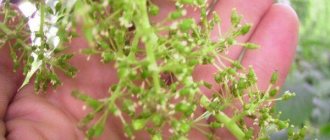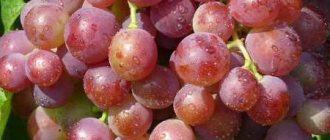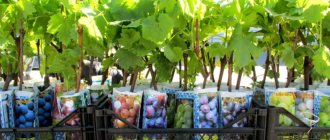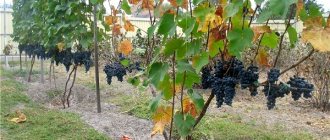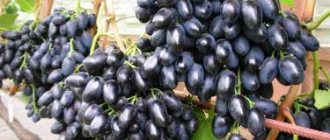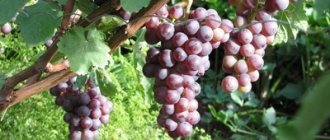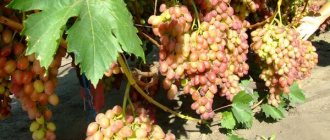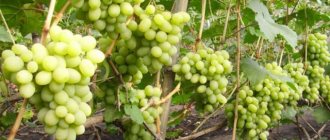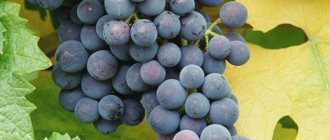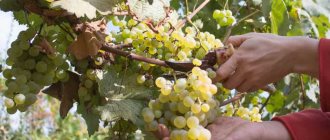A little history
The popular grape variety Cabernet Sauvignon was developed in France in the 17th century. by the method of folk selection. In this state, it is still one of the most widespread of all industrially grown technical varieties. In terms of popularity at the moment, it is second only to Merlot grapes. Breeders found out that Sauvignon Blanc and Cabernet Franc were once its parent varieties.
Currently, this wonderful grape is grown not only in France, but also in many other countries. For example, farmers in the USA, Japan, South America and Mediterranean countries cultivate it. These grapes are grown in Ukraine and Russia.
Technical grapes Cabernet Sauvignon: variety description
The denticles of the grape leaves of this variety are very large. Due to the strong dissection and rounded edges, the plates look “lacey”. The flowers of Cabernet Sauvignon are bisexual, and the clusters are quite loose, but neat. The berries of this variety are small - they reach about 1.5 cm in diameter. The clusters themselves can grow up to 15 cm in length and up to 8 cm in width. They are usually cylindrical (sometimes conical) in shape. In some cases, a wing may form on the bunches.
Cabernet Sauvignon is a grape variety that, among other things, is distinguished by the following characteristic features:
- light green with a reddish tint color of the leaves;
- not too large dark blue berries with rough skin;
- strong spreading shoots.
Descriptive characteristics
Cabernet grapes, let's start the description of this grape variety with where it came from. And he comes from France. One of the most popular Cabernet varieties is Cabernet Sauvignon. Its ancestors are, in principle, considered to be Cabernet Franc and Savignon Blanc.
The Cabernet grape variety has clusters that are approximately 12-15 centimeters long. The weight of one bunch is approximately 70-80 grams. The shape of the bunch resembles a conical-cylindrical one. The total area of one berry is approximately 1.5 cm. The berry is round in shape. The skin of the berry is quite thick. The berries contain seeds, there are about two or three of them.
The flowers of this plant are bisexual. But winegrowers who have grown this plant more than once say that it is more effective to pollinate the bushes yourself. This procedure will be an excellent prevention against peas.
Cabernet berries have a special, memorable smell. They smell like nightshade. The young wine produced from these grapes subsequently has the same smell.
The berries ripen in approximately 140-160 days. If a winegrower wants to make dessert wine from this plant, then it is better to wait as long as possible.
The advantage of Cabernet grapes, of course, is their high resistance to frost. I must say that it tolerates hot weather very well. But if the weather was very hot throughout the ripening period, then you should not hope for a too generous harvest.
Advantages and disadvantages
The benefits of Cabernet Sauvignon, among other things, include:
- ease of care;
- relative frost resistance;
- immunity to mildew and phylloxera.
These grapes are also valued for the fact that they practically do not rot (even during prolonged rains in the fall). The disadvantages of Cabernet Sauvignon include a tendency to shed ovaries and peas.
Pest control and disease prevention
Cabernet Sauvignon almost never gets sick, with rare exceptions. Those growing this grape variety should be wary of:
- spider and grape mites;
- cluster budworm;
- gray rot;
- anthracnose;
- mildew;
- bacteriosis;
- chlorosis.
To protect grapevines from pests and diseases, the bushes are sprayed with insecticides in early spring.
Cabernet Sauvignon is a popular technical grape variety among gardeners, intended for wine production. It is unpretentious in care, grows on any soil, loves warmth, but timely shelter for the winter allows you to grow the vine in the northern regions.
Varieties of Cabernet
Of course, at different times, selection was carried out with such a crop as Cabernet Sauvignon grapes. The description of the variety given above allows us to judge it as one of the best technical varieties to date. Currently, the following forms of this popular grape are grown in different places on the planet:
- Cabernet Cortis. This variety was developed by crossing Sauvignon and Mörzling. These grapes ripen 138-140 days after flowering. Its distinctive feature is its high yield.
- Northern Cabernet. The berries of this variety ripen earlier than Sauvignon - in mid-September. Its distinctive feature is frost resistance (down to -27 C). The bunches of this grape are very small (100 grams), and the bushes are weak-growing.
- Cabernet King. The advantage of this variety is that its flowers bloom later than Sauvignon. And therefore, it is less susceptible to the negative effects of spring frosts.
- Cabernet Michurinsky. These are early ripening grapes, the harvest of which can be harvested within 115-125 days after flowering. The advantages of this variety include high frost resistance (up to -29 C).
- Cabernet Jura. This variety produces very tasty wines with an unusual bouquet. Its advantage is that it is very resistant to various kinds of infectious diseases.
Care
Winegrowers value Cabernet Sauvignon for its ease of care. This hybrid does not cause any trouble; all it needs is regular watering and periodic feeding. The watering regime should be designed in such a way that the soil always remains moist (here we focus on the weather). Feeding is carried out 3-5 times per season. To increase yield, it is best to use organic fertilizers in liquid form. Fertilizing is introduced at intervals of 10-15 days.
After the end of the growing season (mid-July), it is not recommended to apply fertilizers. This will lead to an increase in greenery, which prevents the berries from ripening.
Disease Prevention
Like other plant crops, grapes can be susceptible to disease. Cabernet Sauvignon is most susceptible to diseases of fungal and bacterial origin. To prevent these problems from occurring, you must:
- carry out pruning in spring and autumn so as not to create conditions for high humidity. Read about proper autumn pruning of grapes here.
- immediately remove all damaged , rotting and diseased areas of branches;
- after harvesting, remove all organic waste from the soil around the bush;
- in the spring, when the first buds bloom, spray the plants with antibacterial compounds.
This variety has increased resistance to mildew and is resistant to
gray rot.
Feeding and covering the bushes during cold weather helps strengthen the plants, which also prevents the development of diseases.
Trimming
Pruning allows you to increase the number of fruiting shoots, which has a positive effect on the yield of bushes. There are several pruning methods: short (“on a knot”), long, medium and mixed. This procedure is carried out twice a year. In summer, pruning is pruning and is necessary to reduce green mass. The second event is held either in spring or autumn before wrapping up for cold weather. Read how to prepare grapes for winter here.
To form a Cabernet Sauvignon bush, a short or mixed type of pruning is more suitable. The procedure is carried out as follows: leave 2-3 young buds on the replacement branch, and cut off the old shoot coming from it at an acute angle to the direction of growth. This method helps rejuvenate the bushes. To increase yield, fruiting shoots should be shortened.
It is not recommended to trim grape mustaches. No garter method can replace the natural growth process of the vine.
Choosing a landing site
Cabernet varieties are absolutely undemanding in terms of soil and growing conditions. However, they feel best on southern slopes on nutritious soils. If there is no natural hill on the site, you can make an artificial one. It is better to plant Cabernet Sauvignon grapes in rows from north to south in a well-lit, ventilated area.
The following are usually used as rootstocks for this variety:
- "Riparia 3309";
- "Riparia 101-14";
- "Cobera 5BB";
- "Berlandieri Teleki 8B".
How to care
This variety can be planted in both autumn and spring. The width between the rows should be about 3-4 m. During the warm season, these grapes need to be fed several times. It is best to use organic matter as fertilizer. The last feeding of grapes is carried out in mid-July. Applying fertilizer at a later time may stimulate unnecessary vegetation, which will delay further development of the bunches.
During the ripening period, the Cabernet Sauvignon grape variety needs frequent watering. The frequency of soil moisture beneath it depends on the climatic characteristics of this particular region. You cannot overdo it with watering. Otherwise, the berries may lose their special taste. The last time the soil under the grapes is moistened is in the fall.
Description and features
Cabernet grapes are used exclusively in winemaking and are grown to produce full-bodied red wines. This is a bisexual plant. It bears fruit well without the presence of another pollinator, but in its presence there is an increase in yield. Additional pollination allows you to increase the size of the berries, their weight and the density of the bunches.
It bears fruit with dark berries, the color of which depends on the varietal characteristics. Tolerates heat quite well. With prolonged drought and lack of abundant watering, yields decrease.
Bush formation
Experts advise to be sure to short-prun the annual shoots of this variety of grapes. In this case, the fruiting of the vines will significantly increase as a result of the activation of the lower eyes. Although with high yields this grape practically does not lose its taste, it is recommended to slightly reduce the length of its fruit shoots. This will reduce the load on the bush.
Cabernet Sauvignon is usually grown in tall trunks. In this case, several young growths are left to hang freely. In this case, annual shoots are cut off by about 5-6 eyes.
Reviews about grapes
The Cabernet Sauvignon grape variety, the characteristics of which were given above, has simply excellent qualities. Therefore, there are extremely positive reviews about it on the Internet. The berries of this grape produce simply excellent wine - spicy, tart, and pleasant to the taste.
Actually, this variety itself has gained recognition not only because such an exquisite drink can be prepared from it. Winegrowers speak of it as very unpretentious and productive. When grown, this crop does not cause any trouble. The only thing is that it is advisable to periodically treat the Cabernet Sauvignon grape variety against spider mites and itching. It is recommended to use standard insecticides.
Of course, these grapes are cultivated not only industrially. Summer residents also grow it on their country plots. If desired, you can also prepare wine from it yourself.
